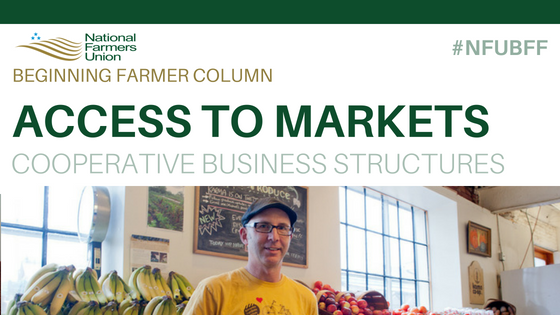 By Jake Stukenberg, NFU Intern
By Jake Stukenberg, NFU Intern
Cooperatives can come in all shapes and sizes. Whether it is a local grocery store stocked with all local products made from area producers or a large company like CHS, Inc. that provides many services nationwide, a cooperative caters to a specific need and improves access to goods or services for all consumers and producers. There are several different kinds of cooperatives business structures, including marketing, purchasing, and service cooperatives.
Marketing cooperatives assemble, grade, and ship products. The most common places that this cooperative model is found is in the dairy, grain, cotton, livestock, and fruit and vegetable industry. One of the most well-known marketing cooperatives is Land O’ Lakes, a marketing cooperative based out of Minnesota.
Land O’ Lakes has specialized in the dairy business, specifically butter production, since 1921. They made $14 billion dollars in net sales in 2017, and $149 million dollars of those sales were returned to the 751 members of the coop.
Purchasing cooperatives cater to the needs of consumers by providing inputs and services. They serve farmers and ranchers by allowing better prices and access to the products that make their farm operate, such as fertilizer, feed, crop protection chemicals, and petroleum. CHS, Inc. is a great example of a purchasing cooperative. They provide a wide access to fuel (Cenex gas stations), provide processing for many grains, and even provide access to local crop nutrient dealers.
Service cooperatives, as the name suggests, provide services and can be formed in a variety of industries. Electric companies, credit unions, telecommunication service providers, and hardware stores are all examples of service cooperatives in action.
One example of a service cooperative that caters to agriculture professionals as well as rural homeowners and other cooperatives is the Farm Credit System. The Farm Credit System specializes in providing long-term loans to farmers, ranchers, and harvesters for farm-related business activities. These banks also provide short term and long-term loans like home loans and cooperative loans to other non-farming members of the credit union. They have 72 branches of four main bank systems, which are AgriBank, CoBank, Farm Credit Bank of Texas, and AgFirst Farm Credit Bank.
These are just a few of the many cooperative business forms. In the next post, we will explore other examples of cooperatives that benefit rural communities, such as cooperatively owned grocery stores, local credit unions, and cooperatively run farm businesses.
Know of any other businesses or cooperatives that benefit rural communities? Drop comments in the section below so others can check out their local businesses!
Like what you’ve read? Check out our Beginning Farmer Forum home page, and join the conversation in the Beginning Farmer Forum Facebook group.

